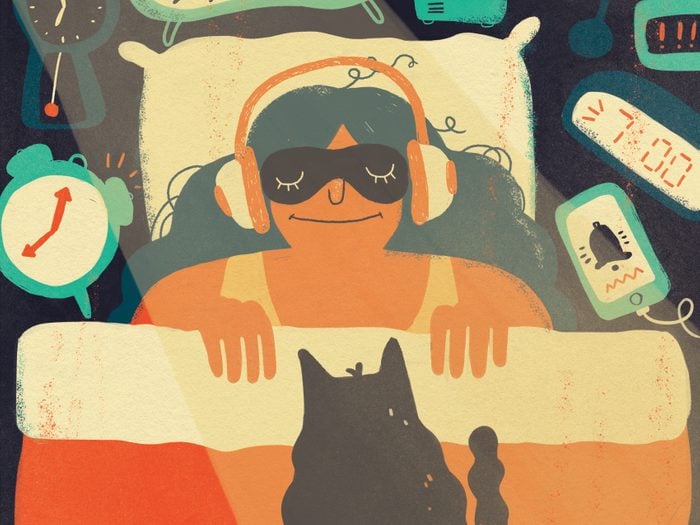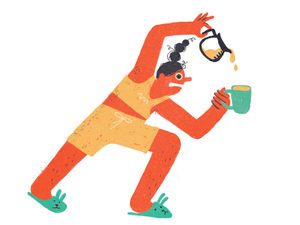5 Ways to Make Your Mornings Better, According to Science

For many of us, kick-starting the morning isn’t as easy as it used to be. So we’ve uncovered five underrated, science-backed rituals that could help.
The birdsong starts just as the sun breaks over the horizon. You stretch your arms over your head, crack a huge smile and swing your feet down to the floor.
Or, maybe that’s not quite how it goes. Cold, dark winter mornings are unwelcoming. The stress and anxiety of the pandemic may be making it harder to get a good night’s sleep. (A 2021 survey from the DNA testing company 23andMe reported that 23 percent of respondents were waking up at night more than usual.) And being underslept makes those initial waking hours all the more difficult to get through.
For many of us, kick-starting the morning isn’t as easy as it used to be. So we’ve uncovered five underrated, science-backed rituals that could help. While they might not transform you into an early bird, these tweaks to your routine will put a little more spring in your step.
Change up your wake up
It’s a luxury that isn’t available to everyone, especially those on a strict 9-to-5 work schedule, but turning off your alarm to wake up naturally could be beneficial to your health, according to the Munich-based researcher Till Roenneberg. For some of us, morning alarms end our sleep cycles too soon. That’s because we each have a chronotype, which is a natural desire to sleep at a certain time. Morning types find it easy to go to bed early and get up in the morning while evening types usually don’t feel sleepy until after 1 a.m. That means night owls might be depriving themselves of necessary shut-eye when they have to log on early for work. Chronic sleep deprivation contributes to an increased risk of obesity, hypertension, diabetes, depression, heart attack and stroke. Ditching the alarm, however, lets our bodies get the amount of sleep we need.
How we wake up and go to sleep is governed by two different processes, explains Dr. Elizabeth B. Klerman, a professor of neurology at the division of sleep medicine at Harvard Medical School and a research investigator at Massachusetts General Hospital. The homeostatic process is how long you’ve been awake or asleep. “If you’ve been asleep for a long period of time, you’re more likely to wake up,” says Klerman. The second cycle is our circadian rhythm, controlled by a part of the brain called the suprachiasmatic nucleus. It’s like an internal clock or pacemaker. “It governs when you feel awake and alert, when you fall asleep and when you wake up.”
Different parts of our brains wake up at different times, according to Klerman. If an alarm wakes us up prematurely, we might still be in deep sleep, which leaves us with sleep inertia—that uncomfortable feeling of grogginess. “If you’ve woken up spontaneously, you might have a little bit of sleep inertia,” she says. “You’re not ready to do physics, but part of your brain is awake to turn off the alarm clock, get out of bed and start working. [However], part of the brain is still waking up. And so you feel like you’re groggy.”
With new remote work policies eliminating many morning commutes and making flextime perks more common, more of us have the option to sleep in and retire our alarm clocks. A July 2020 study from the Journal of Public Health Research surveyed 1,511 adults and found that their average wake-up time had been delayed by about 51 minutes during the initial COVID lockdown in March 2020, compared to before lockdown.
When I quit my 9-to-5 job to become a freelance journalist in 2013, I had the joy of regularly waking up without an alarm clock for the first time in my adult life. True, the liberating career change might have contributed to me feeling fresher, more alert and happier. But I now naturally wake up between 8 and 9 a.m. every day, and most days I feel great when I get up. A 2021 survey conducted by the sleep health website Each Night found that respondents who woke up without an alarm were 10 percent more likely to feel well-rested than those who woke up with an alarm. Respondents who didn’t use an alarm were also more likely to report being in a positive mood and not feeling rushed during the day.
My mom is a naturally early riser, getting up at 6 a.m. or earlier. So I always felt guilty for sleeping past the crack of dawn, as if that made me lazy or unmotivated. But ever since I found my own rhythm as a freelancer and ditched my morning alarm, I’m so much more productive and happy.

Follow the light
As tempting as it is to lie in bed and scroll on your phone before getting up, Dr. Raed Hawa, a sleep medicine specialist at Toronto Western Hospital, advises against it. Instead, we should expose ourselves to sunlight as soon as possible after waking.
“Light exposure during the day helps to regulate your sleep-wake cycle,” Hawa explains. Early-morning daylight exposure helps us feel alert during the day while also encouraging sleepiness at night when we need to get to bed.
Natural light is the best option, according to Hawa. Fewer of us may be fetching the newspaper from our front porch in slippers and a bathrobe, but it’s not a bad idea to bundle up and step outside first thing in the morning. “By going out, you are being behaviourally activated by the natural light, the air, smells, nature,” says Hawa. “Therefore, you’re going to be more alert. There’s the physical activity as well that you’re doing by going outside.”
(Related: 5 Best Light Therapy Lamps on Amazon Canada for Seasonal Affective Disorder)
So does the light from your phone screen or simply turning on a lamp count, too? Not quite. For shift workers or early risers who get up before sunrise, Hawa recommends a light therapy box to mimic the correct type and quantity of exposure. “It is very specific how much intensity you get with a light box,” he explains. Most emit light at 10,000 lux—a measurement of light brightness—that best regulates our sleep-wake cycles. “You should put it within an arm’s length of you when you wake up in the morning.”
And as tempting as it is to pair this early-morning light exposure with a cup of coffee, it might be better to delay that first hit of caffeine until an hour or two after you get up. That’s because our body’s cortisol levels are higher when we first wake up, giving us a natural boost of energy and focus. A caffeine kick at this time won’t be as effective, so holding off helps give you a more sustained boost of energy throughout your morning.

Douse yourself in chilly water
Yes, yes, a cold shower is a tough sell. But Katy Poon, a user experience design consultant from Vancouver, swears by this frigid yet effective morning ritual, and science backs her up. “I try to be under the cold for at least a minute,” Poon explains. She’ll then transition to warmer water for the rest of her shower.
Poon says that she feels “shock” at first, then a rush of adrenaline. “Honestly, it is quite addictive. The secret is to not hesitate and just jump in.” Poon first started the habit in 2013 when she began riding her bike to the office. “The building was at the top of a hill and I would always sprint up,” she says. “I had to find a way to cool down before the morning meetings.”
Acute cold exposure has immuno-stimulating effects, especially after physical exercise, according to a 1999 study in the Journal of Applied Psychology. This means that cold water could help increase immune system activity to help your body fight infections and diseases. A 2015 study from Amsterdam found that people who, for 30 days, had a hot shower followed by up to 90 seconds of a cold shower had a 29 percent reduction in absences from work due to sickness. And a 2008 paper from a journal called Medical Hypotheses proposed cold showers as a treatment for depression. “Due to the high density of cold receptors in the skin, a cold shower is expected to send an overwhelming amount of electrical impulses from peripheral nerve endings to the brain, which could result in an anti-depressive effect,” the paper’s author, Nikolai A. Shevchuk, wrote. That means a cold shower could be a natural way to give your body a boost of feel-good hormones.

Get a (tiny, little) move on
As glorious as sleep is, it can cause problems for our joints and muscles. Lack of movement, or sleeping on body parts (most commonly the hands or arms), limits blood flow, causing muscle tightness and stiffness. A 2005 study in the Korean Journal of Adult Nursing found that morning stretching lowered levels of depression and promoted feelings of motivation among stroke patients in rehabilitation.
Renata Szado, a physiotherapist at Tenzr Health, a wearable rehab technology company based in Surrey, B.C., recommends light morning stretches to ease muscle strain and get our bodies ready for the day. Before that, though, it’s important to do 30 minutes of movement—such as walking, light exercise or even the regular activity like showering and dressing involved in morning routines—to generate blood flow around your body and allow your muscles to stretch safely. “I suggest keeping movements and stretches so light in the morning that you can barely feel them initially,” Szado explains. “Continually focus on relaxing the muscle and letting the stretch relax to a point where you can’t feel it.”
(Related: How 60-Second Fitness and Wellness Activities Can Boost Your Health)
For neck stiffness, use your left hand to gently bend your neck to the side, left ear to left shoulder, until a stretch is felt. Hold for one minute and repeat three times. Then repeat on the right side.
Experiencing lower back pain? Lie with your back on the floor and bring your knees to your chest while keeping the neck, shoulders and back relaxed. Wiggle from side to side gently, keeping your upper back and shoulders on the floor. As you exhale, consciously relax further, feeling a gentle stretch. Repeat three times.
If you’ll be on your feet for the rest of the day, Szado recommends doing a few back bends. When standing, place your hands on your lower back. Reach the hips forward as you arch the head and upper back gently, keeping the neck long. Hold for the stretch for two seconds, then activate your core and squeeze your glutes as you come back up to standing. Repeat five times.
For those who will be sitting all day, Szado recommends a letter T stretch. Lie on your back with your knees bent, then slide your chin down to lengthen the back of your neck. Gently flatten your lower back to the ground so there’s no arching. Bring your arms up to shoulder height on the ground, palms facing up, making a T shape with your body. Gently press backs of hands, wrists, elbows and shoulders into the ground. Feel the chest and front of the shoulders lengthening but don’t force your arms back. Hold this position for one minute. Repeat three times.
Eat dinner for breakfast
The sweet yogurts, refined cereals and granola bars that we associate with healthy mornings could actually lead to hangry moments soon after eating, according to Dakota Sinasac, a registered dietitian at Six Nations Health Services in Ontario. “Starting off the day with a bunch of sugar can cause spikes and crashes in your energy levels,” she says. “With foods that are higher in sugar, your blood sugar is ramping up really, really fast. Your body recognizes that and it compensates by crashing it back down.”
A better option is to shift your breakfast foods from sweet to salty. By eating savoury breakfasts, says Sinasac, “you’re more likely to have adequate sources of protein with the meal and a little bit more of those nutritious fats that can help you feel full longer.” A 2015 study couldn’t find enough data to determine if eating breakfast is good for you, but did find that protein matters: It showed that a high-protein breakfast reduces hunger later in the day.
Protein and whole grains take longer for your body to digest, resulting in a more sustained source of energy that’ll bring you to lunchtime before you get hungry again. Weekday sweet-to-savoury swaps involve some thinking outside the box. “Instead of a regular blueberry muffin, you could do egg muffins and include a little bit of spinach, peppers and turkey bacon in there,” Sinasac suggests. Instead of instant oatmeal, which tends to have lots of added sugar, make your own with steel-cut oats and top it with steamed spinach, tomatoes and an egg. Or, go savoury with your morning smoothie by swapping fruit for vegetables, like celery, kale and dried seaweed powder or rehydrated kelp for a nutrient-rich kick.
(Related: Why Vegetarians May Want to Add Nori to Their Diet)
Sinasac recognizes that savoury breakfasts usually require more prep time than pre-packaged sugary options. If you’re already batch-cooking your lunches and dinners, consider adding savoury breakfasts to that routine. “A lot of these foods you can prep ahead of time for the week,” she says. “They last in the fridge or the freezer and they’re easy to pull out.”
Sugary breakfasts may be the norm in North America, but there are many other places and cultures around the world that traditionally serve a savoury dish first thing in the morning. For example, in Hong Kong, macaroni noodle soup with mixed vegetables is topped with a fried egg or spam for breakfast. And in Venezuela, eating arepas—baked corn flour bread filled with eggs, cheese, meat or beans—is a common way to start the day.




